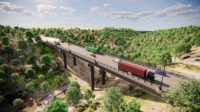Construction is officially underway to replace the Walk Bridge, the troublesome 127-year-old Norwalk, Conn., railroad crossing with a new, more reliable structure better suited to the northeast’s growing volume of passenger traffic.
A May 14 groundbreaking ceremony in Norwalk signaled the beginning of the six-year, $925-million Connecticut Dept. of Transportation project, which calls for two independent, two-track vertical lift spans to be built around the existing four-track swing bridge spanning the Norwalk River to safely preserve two-track service throughout construction. The HNTB-designed replacement bridge will also include 145-ft-tall lift towers that will lift each of new 240-ft-long spans approximately 60 ft, providing redundancy in the event of a track outage. New fixed east and west approaches, embankments and abutments will also be built.
CTDOT has tapped the joint venture of Cianbro Corp., Pittsfield, Maine, and Middlesex Corp., Littleton, Mass., for the project, which marks the state’s first use of construction manager/general contractor (CMGC) project delivery. WSP is providing program management, construction engineering and inspection services. The federal government is providing 80% of the Walk Bridge’s funding, with the remainder coming from the state.
Opened in 1896, the existing 565-ft-long structure is one of the oldest moveable rail bridges in the region, according to CTDOT, and has increasingly shown its age for more than a decade through repeated operational issues and service disruptions. Approximately 175 Metro-North commuter rail and Amtrak Northeast Corridor trains cross the truss swing bridge each day. The existing bridge has three fixed spans and one movable span.
Minimizing the risk of construction-phase disruptions to both rail and river traffic has been a priority since 2017, when work began on a separate enabling project to install a four-track interlocking system within a 3,200-ft corridor that includes the bridge. Commissioned for operation in late 2023, “the new interlocking facilitates moving the trains to maintain two-track service during construction of the new bridge,” explains WSP project manager Kevin Washburn.
The new crossing’s initial work, targeted for completion by the end of 2025, includes building the new lift tower foundations and drilling a new microtunnel beneath the river to accommodate overhead power and communications lines currently located on high towers owned by a regional energy provider and scheduled for removal. Three smaller rail bridges in the corridor are also set to undergo upgrades during this period.
With steel fabrication for the spans and lift towers expected to take as much as 22 months, WSP plans to issue an early procurement package later this year. If all goes as scheduled, Washburn says CTDOT will arrange a two-week closure of river traffic during the winter of 2027-28 so that the new south span can be floated into place. A similar approach will be used to install the north span the following winter.
Timing will be critical to maintaining the project’s schedule, Washburn says, noting that multiple tasks must come together by the end of 2025 in order for the team to meet its follow-on milestones.
“Missing an approved river closure period could cause the program to slip by a year,” he says, adding that that project team will also be challenged by the bridge’s location in an older section of Norwalk, with several historic buildings nearby.
“It’s very, very tight,” Washburn says.
He expects the project will benefit significantly from the CMGC approach, which has already fostered valuable collaboration with the Ciambro/Middleton team.
“It has been very helpful for getting feedback, constructability assessments and alternatives so that we could get what we were going to do permitted,” he says.





Post a comment to this article
Report Abusive Comment